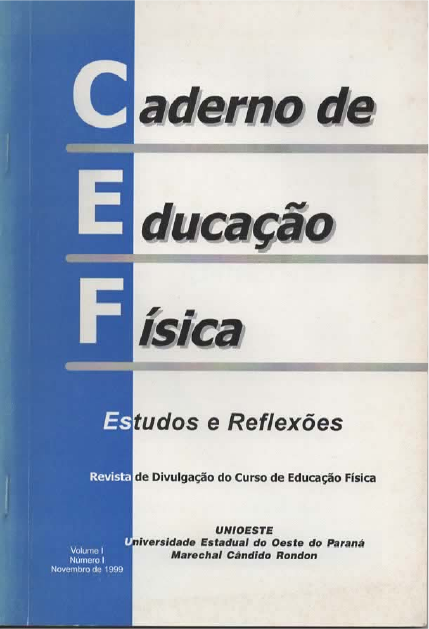Body composition and oxygen consumption: a review study
DOI:
https://doi.org/10.36453/cefe.1999.n1.p49Keywords:
Body composition , Oxygen Consumption, AdultsAbstract
The study reviews the literature to analyze the association between maximum oxygen consumption (VO2max) and body composition parameters, focusing on how these elements interact in physical performance and cardiovascular health. Body composition, often measured in physical activity centers, is usually associated with VO2max as an indicator of aerobic fitness. Analyzed studies indicate that high levels of body fat are inversely proportional to oxygen consumption, while individuals with higher lean body mass show better aerobic performance. Early research, such as that of Buskirk & Taylor (1957), shows a strong correlation between VO2max and lean body mass (r = 0.85), reinforcing the relevance of this metric in cardiorespiratory fitness assessments. Later studies confirmed this relationship but highlighted that excess body fat alone does not directly influence maximum aerobic performance, being more relevant in activities involving body displacement, such as running. Additionally, significant differences in the VO2max/body composition relationship were observed between genders and age groups. The review concludes that, for young adults and adolescents, lean body mass is the best predictor of aerobic performance. However, in women and the elderly, body composition presents specificities that require further investigation. Body fat, when maintained at high levels for long periods, significantly contributes to the development of cardiovascular diseases in older populations. Thus, the study reinforces the importance of personalized approaches in exercise prescription.
Downloads
References
BARR, S.; McCARGAR, L.; CRAWFORD, S. Practical use of body composition analysis in sport. Journal of Sports Medicine, v. 17, n. 5, p. 277-282, 1994.
BUSKIRK, E. R. Body composition analysis: the past, present and future. Research Quarterly for Exercise and Sport, v. 58, n. 1, p. 1-10, 1987.
BUSKIRK, E. R.; TAYLOR, H. L. Maximal oxygen intake and its relation to body composition, with special reference to chronic physical activity and obesity. Journal of Applied Physiology, v. 2, n. 1, p. 72-78, 1957.
BRAY, G. A. Obesidad. In: International Life Science Institute. Present Knowledge in Nutrition. 6th ed. ILSI: North America, 1990, p. 28-46.
GUO, S. et al. Cardiovascular disease risk factors and body composition: a review. Nutrition Research, v. 14, n. 11, p. 1721-1777, 1994.
HARTUNG, G. H. et al. Prediction of maximal oxygen uptake from submaximal exercise testing in aerobically fit and nonfit men. Aviation, Space and Environmental Medicine, n. 64, p. 735-740, 1993.
SUTTON, J. R. Limitations to maximal oxygen uptake. Journal of Sports Medicine, v. 13, n. 2, p. 127-133, 1992.
WATANABE, K. et al. Relationship between body composition and cardiorespiratory fitness in Japanese junior high school boys and girls. Annals of Physiological Anthropology, v. 13, n. 4, p. 167-174, 1994.
WELCH, B. et al. Relationship of maximal oxygen consumption to various components of body composition. Journal of Applied Physiology, v. 12, n. 3, p. 395-398, 1958.
WILMORE, J. H. Body composition, sport, and exercise: directions for future research. Medicine and Science in Sports and Exercise, v. 15, n. 1, p. 21-31, 1983.
WILMORE, J. H. Sport medicine. In: Lohman, Roche & Martorell (Eds.). Anthropometric Standardization Reference Manual. Champaign: Human Kinetics, 1988, p. 155-159.
Downloads
Published
How to Cite
Issue
Section
License
Copyright (c) 2000 Direitos Autorais Partilhados

This work is licensed under a Creative Commons Attribution-NonCommercial-ShareAlike 4.0 International License.
Os direitos autorais permitem descarregar, compartilhar, copiar, distribuir, adaptar, transformar, exibir, reproduzir a totalidade ou partes do artigo para qualquer propósito legal, desde que não tenha fins lucrativos e seja citada a fonte.
Informamos que todo o conteúdo do texto publicado, e dos seus possíveis erros ortográficos e gramaticais, é de inteira responsabilidade de seus autores, não cabendo ao Caderno de Educação Física e Esporte, ou aos nossos Avaliadores Ad Hoc, por qualquer implicação legal ou por eventual negligência à língua portuguesa ou à estrangeira.



















